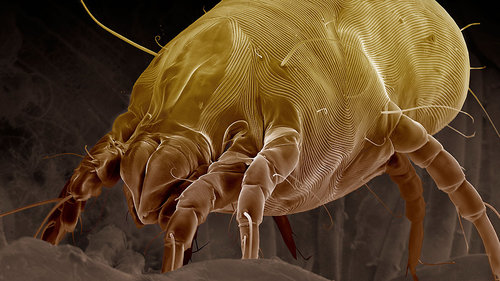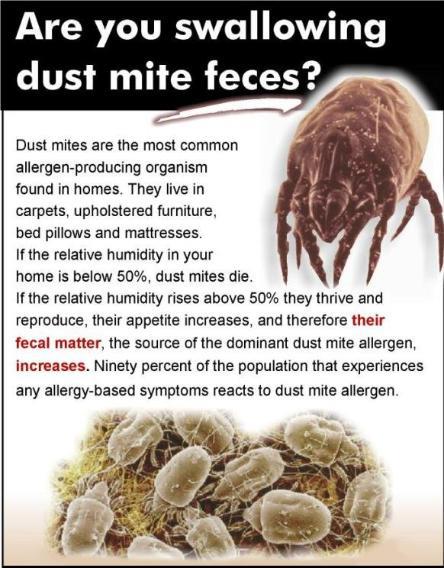Can Your Mattress Make You Sick?
It’s almost unthinkable for many folks, and because our parents, like their parents before them, taught us to make our beds every morning so they looked neat and tidy, we are accustomed to this morning ritual. New science however, strongly suggests that making your bed provides the perfect environment that dust mites need to build a thriving settlement, right where you sleep.
Actually, your bed is more like a sprawling urban wasteland inhabited by up to 1.5 million dust mites, who thrive on moisture, skin cells, and fluids discharged by our bodies during the night. And, like humans, dust mites produce up to twice their weight in feces every day, our sheets and bed linens being the sewage treatment plant for these ghastly creatures.
Potentially dangerous bacterial micro-organisms, including dust mites, have been found thriving in the airways of adults with chronic asthma. One of these fungal organisms, Aspergillus peicilloides, feeds on dust mite feces.
The allergens produced by the dust mite feces are inhaled while we sleep and are know to cause asthma, worsen allergies, and create other respiratory ailments. It’s no different than rolling around in mouse or rat droppings, some scientists say.
Science Backs Leaving Your Bed IN a Heaping Mess IN the Morning
There’s sound science behind wrinkled sheets and piles of unfolded comforters. Consider our physiology. The typical individual drinks around 2.8 liters of fluids per day through sweating, tear ducts, salivating, and other bodily fluid emissions. Breathing alone requires exhalation of large amounts of water. Even a camper knows that you need to air out your sleeping bag on a daily basis to avoid reduction of insulation qualities, decreasing the horrific smell that accumulate as bacterial feast on the moisture and skin cells.
Unaired blankets also serve as fomites (surfaces that sustain micro-organism life long enough for transfer from one surface to another) for blood thirsty parasites. In fact, up to 50% of the weight of a down-filled comforter may consist of deceased dust mites and their feces. Hotel maids are known to suffer from something called “bed maker’s lung,” a form of alveolitis brought on by repeated exposure to dust mite feces.
It makes total sense then that during the night while we are tossing and turning, our skin is flaking off in sheets, moistened into a delicious mush providing an endless casino like buffet, helping to feed and perpetuate our resident steadily growing population. Dust mites thrive in the environments we create by taking in water through small glands on the exterior of their bodies.

As soon as we wake up, we instinctively make our bed, covering the scales, sweat, dust mite feces, and fluids and providing a perfect hot mess environment for breeding and feasting.Many experts say stop making your bed in the morning, and let it air out for the majority of the day, making it up late in the afternoon, perhaps after coming home from work. Many experts say stop making your bed in the morning, and let it air out for the majority of the day, making it up late in the day, perhaps after coming home from work. Fresh air, sunlight, and oxygen, as well as ozone can refresh your bed and kill off untold millions of deadly intruders.
Wash your bed linens at least twice a week, and be sure to use a mattress protector, a type that fits your mattress like a fitted sheet as a first line of defense against moisture and preventing residue and bodily secretions from destroying your mattress.
more tips and pointers to control dust mites and allergens
Another way to help kill off dust mites is by reducing the humidity in your home. Getting the humidity down to below 50 percent, even to 35-40, will quickly destroy dust mite populations by depriving them of critical moisture levels. “There is a fine line between feeding and maintaining a mite population, and just a tiny amount of dry air can obliterate them”, says bedding CEO and mattress expert Marc Anderson.

Use a moisture testing device call a hygrometer (you can buy them at Home Depot, Lowe’s) to assess the humidity level in your home, and you can park a dehumidifier in your room, set it to high next to your unmade bed, and expect a significant reduction in dust mite populations and allergens.
Removing aquariums, water features, and fixing leaky plumbing adjacent to your bedroom can also greatly influence the humidity levels in your sleeping environment. Here are some tips and pointers that help reduce dust mites and allergens:
Install zippered, dust-proof allergen covers on mattresses and pillows. Most are made with a permeable membrane that allows air to pass, but will not permit moisture or particulate matter into your mattress.
Wash protectors, sheets, pillow cases and duvets, blankets and coverings once a week in hot water. If you are short on time, at least wash sheets and pillow cases once per week.
Use a handheld vacuum on your bed as it will remove some of the fecal matter, though not dust mites themselves. Use a high-efficiency air filter and bags that provide micro filtration (HEPA)
Keep animals off of your bed and preferably out of your bedroom.
Avoid wall to wall carpeting or excessively thick carpeting when possible. Use throw rugs, and if you have a tiled or wooden floor, you can easily remove dust, particulate matter and allergens.
Use higher quality, high efficiency filters for your furnace and air conditioner with a value rating of 11 or 12.
- People who suffer from allergies should wear a dust mask while cleaning. They’re inexpensive and readily available at Home Depot or Lowe’s.
About 50 percent of people are allergic to dust mites, and if you continue to have issues after doing your best to remove or kill off a dust mite population, you might want to see a board-certified allergist.
While not making your bed helps to reduce the local dust mite population on your mattress, you need to consider other ways to reduce the population in other parts of your house. Dust mite particles can become airborne, and travel to any horizontal surface in your home, from carpeting to furnitures, food prep surfaces and more.
Humidity is the real source of the problem in most homes. The average person can have up to 1.5 million dust mites in his or her bed, and they can actually produce two times their weight in fecal matter. Getting the humidity down in your house may help. “If you can get your humidity down below 50 percent — ideally between 35 to 40 percent — that is going to destroy the mite populations”, according to one pest management expert.
Use a hygrometer to measure the humidity in your house, and then use a dehumidifier when it gets too high, the expert recommends. Here are other ways to address dust mites.
The “Small Gland Theory”- A UK Scientist Discusses Dust Mites And Bed Making
UK scientists developed a computer model to track how changes in the home can reduce numbers of dust mites in beds. Dr. Stephen Pretlove, an entomologist in Great Britain states:
“We know that mites can only survive by taking in water from the atmosphere using small glands on the outside of their body. Something as simple as leaving a bed unmade during the day can remove moisture from the sheets and mattress so the mites will dehydrate and eventually die.”
In one ingenious element of their dust mite and bed making research, the scientists installed “mite pockets” into beds in 36 houses around the United Kingdom to test their computer model to investigate how people’s daily routines affect mite populations. The study confirmed that mites quickly dry out and die when bed linens and coverings are not placed over the pockets during the day, and that exposure to air is effective to rapidly kill dust mites, thus eliminating egg case and fecal contamination, which can cause allergies to flare up with many people.
Building features such as heating, ventilation and insulation were also altered to monitor how the mites cope. Dr Pretlove said the research had the potential to reduce the $600 million spent treating mite-induced illnesses each year in the UK. “Our findings could help building designers create healthy homes and healthcare workers point out environments most at risk from mites.”